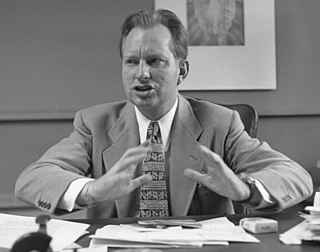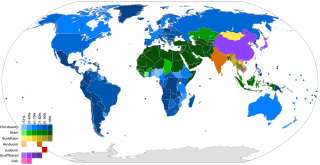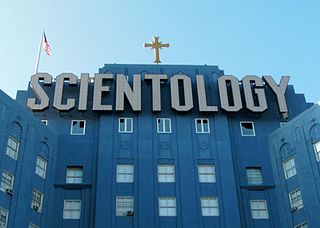
Dianetics is a set of ideas and practices, invented in 1950 by science fiction writer L. Ron Hubbard, regarding the human mind. Dianetics was originally conceived as a form of psychological treatment, but was rejected by the psychological and medical establishments as pseudoscientific. It was the precursor to Scientology and has since been incorporated into it. It involves a process referred to as "auditing", which utilizes an electrical resistance meter, ostensibly to remove emotional burdens and "cure" people from their troubles.

Lafayette Ronald Hubbard was an American author and the founder of Scientology. A prolific writer of pulp science fiction and fantasy novels in his early career, in 1950 he authored Dianetics: The Modern Science of Mental Health and established organizations to promote and practice Dianetics techniques. Hubbard created Scientology in 1952 after losing the intellectual rights to his literature on Dianetics in bankruptcy. He would lead the Church of Scientology – variously described as a cult, a new religious movement, or a business – until his death in 1986.

A sect is a subgroup of a religious, political, or philosophical belief system, typically emerging as an offshoot of a larger organization. Originally, the term referred specifically to religious groups that had separated from a main body, but it can now apply to any group that diverges from a larger organization to follow a distinct set of beliefs and practices. Sects often form when there is a perception of heresy either within the subgroup or from the larger group.

Followers of the Scientology movement maintain a wide variety of beliefs and practices. The core belief holds that a human is an immortal, spiritual being (thetan) that is resident in a physical body. The thetan has had innumerable past lives, some of which, preceding the thetan's arrival on Earth, were lived in extraterrestrial cultures. Based on case studies at advanced levels, it is predicted that any Scientologist undergoing auditing will eventually come across and recount a common series of past-life events.

Massimo Introvigne is an Italian sociologist of religion, author, and intellectual property attorney. He is a co-founder and the managing director of the Center for Studies on New Religions (CESNUR), a Turin-based nonprofit organization which has been described as "the highest profile lobbying and information group for controversial religions".
The anti-cult movement, abbreviated ACM and also known as the countercult movement, consists of various governmental and non-governmental organizations and individuals that seek to raise awareness of religious groups that they consider to be "cults", uncover coercive practices used to attract and retain members, and help those who have become involved with harmful cult practices.

Dianetics: The Modern Science of Mental Health, sometimes abbreviated as DMSMH, is a book by L. Ron Hubbard describing a pseudoscientific set of ideas, Dianetics, that would later become part of Scientology. Hubbard claimed to have developed it from a combination of personal experience, basic principles of Eastern philosophy and the work of Sigmund Freud. The book is considered part of Scientology's canon. It is colloquially referred to by Scientologists as Book One. The book launched the movement, which Hubbard later characterised as a religion, in 1950. As of 2013, the Scientology organization's publishing arm, New Era Publications, sells the book in English and in 50 other languages.

Stephen A. Kent is a professor in the Department of Sociology at the University of Alberta in Edmonton, Alberta, Canada. He researches new religious movements (NRMs), and has published research on several such groups including the Children of God, the Church of Scientology, and other NRMs operating in Canada.

The Church of Scientology is a group of interconnected corporate entities and other organizations devoted to the practice, administration and dissemination of Scientology, which is variously defined as a cult, a business, or a new religious movement. The movement has been the subject of a number of controversies, and the Church of Scientology has been described by government inquiries, international parliamentary bodies, scholars, law lords, and numerous superior court judgements as both a dangerous cult and a manipulative profit-making business.

History of Dianetics and Scientology begins around 1950. During the late 1940s, L. Ron Hubbard began developing a mental therapy system which he called Dianetics. Hubbard had tried to interest the medical profession in his techniques, including the Gerontological Society, the Journal of the American Medical Association, and the American Journal of Psychiatry, but his work was rejected for not containing sufficient evidence of efficacy to be acceptable.

A Piece of Blue Sky: Scientology, Dianetics and L. Ron Hubbard Exposed is a 1990 book about L. Ron Hubbard and the development of Dianetics and Scientology, authored by British former Scientologist Jon Atack. It was republished in 2013 with the title Let's sell these people A Piece of Blue Sky: Hubbard, Dianetics and Scientology. The title originates from a quote of Hubbard from 1950: an associate of Hubbard's noted him saying that he wanted to sell potential members "a piece of blue sky".
The Church of Scientology publicly classifies itself as a religion, but scholars and other observers regard it as a business, because the organization operates more like a for-profit business than a religious institution. Some scholars of sociology working in religious studies consider it a new religious movement. Overall, as stated by Stephen A. Kent, Scientology can be seen as a "multi-faceted transnational corporation that has religion as only one of its many components. Other components include political aspirations, business ventures, cultural productions, pseudo-medical practices, pseudo-psychiatric claims, and, an alternative family structure."

Scientology: The Now Religion is a book on Scientology, written by George Malko. The book was published in 1970 in Hardcover format by Delacorte Press, and then in a paperback edition in 1971, by Dell Publishing. The book was the first full-length analysis of the history surrounding the founding of the Church of Scientology, and L. Ron Hubbard. Malko conducted interviews with members, and provides analysis about certain practices.
Roy Wallis (1945–1990) was a sociologist and Dean of the Faculty of Economics and Social Sciences at the Queen's University Belfast. He is mostly known for his creation of the seven signs that differentiate a religious congregation from a sectarian church, which he created while researching the Church of Scientology. He introduced the distinction between world-affirming and world-rejecting new religious movements.

Various sociological classifications of religious movements have been proposed by scholars. In the sociology of religion, the most widely used classification is the church-sect typology. The typology is differently construed by different sociologists, and various distinctive features have been proposed to characterise churches and sects. On most accounts, the following features are deemed relevant:

Scientology is a set of beliefs and practices invented by the American author L. Ron Hubbard, and an associated movement. It is variously defined as a cult, a business, a religion, or a scam. Hubbard initially developed a set of ideas that he called Dianetics, which he represented as a form of therapy. An organization that he established in 1950 to promote it went bankrupt, and Hubbard lost the rights to his book Dianetics in 1952. He then recharacterized his ideas as a religion, likely for tax purposes, and renamed them Scientology. By 1954, he had regained the rights to Dianetics and founded the Church of Scientology, which remains the largest organization promoting Scientology. There are practitioners independent of the Church, in what is referred to as the Free Zone. Estimates put the number of Scientologists at under 40,000 worldwide.

Scientology in the United Kingdom is practised mainly within the Church of Scientology and its related groups which go under names including "Hubbard Academy of Personal Independence" and "Dianetics and Scientology Life Improvement Centre". The national headquarters, and former global headquarters, is Saint Hill Manor at East Grinstead, which for seven years was the home of L. Ron Hubbard, the pulp fiction author who created Scientology. In the 2021 census, there were 1,844 individuals in England and Wales who listed themselves as Scientologists in their census returns, almost half of which lived in the area around East Grinstead in West Sussex, which hosts the British Scientology Headquarters at Saint Hill Manor. This is a decline of just under a quarter since census day, 2011.
This is a bibliography of works critical of Scientology and the Church of Scientology.
From 1953 to 1967, L. Ron Hubbard was the official leader of the Church of Scientology.










